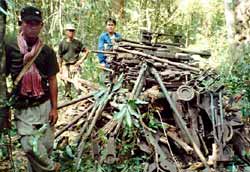|
Weapons Caches

The cache team collect all the weapons from the cache in order to make an inventory and sunsequently destroy the weapons.
|
After the cessation of hostilities in 1998, the Royal Government embarked on a successful programme to collect weapons back from the civil population and demobilized soldiers. However, much of the fighting and movement of armed forces during the civil war occurred in remote, forested areas of the country where large numbers of weapons are thought to remain.
The Khmer Rouge were experts at moving quickly and lightly through near- impenetrable areas and often buried significant quantities of weapons in specific areas to facilitate the swifter movement of guerrilla troops. Forces from other factions also buried weapons in order to prevent them falling into enemy hands or as a future insurance policy should peace not hold. Areas such as the Cardomom Mountains in the south west of Cambodia, the Damreks in the north and the huge forest areas surrounding previous Khmer Rouge strongholds or bases are where many weapons are considered to be hidden.
At the request of H.E. Sar Kheng, Deputy Prime Minister, Co-Minister of the Interior and Chairman of the National Commission for Reform and Management of the Weapons and Explosives in Cambodia, EU ASAC became actively involved in the search for and destruction of weapons found in caches throughout the country.
On 21 May 2003 a Project of Cooperation was signed by H.E. Em Sam An, Secretary of State, Ministry of Interior, Permanent Member of the National Commission for Reform and Management of the Weapons and Explosives in Cambodia and Mr. David de Beer, Project Manager of EU ASAC.
Weapon caches were reported to EU ASAC in seven provinces. All of these caches are in remote mountainous and forested areas and few were able to be reached. However in 2003 and 2004 a total of 624 weapons, 1,062 rounds of ammunition and 103 grenades were recovered by the EU ASAC weapons cache team. The weapons were later destroyed in Flames of Peace ceremonies.
|

![]()